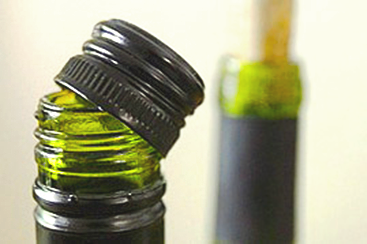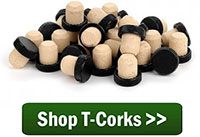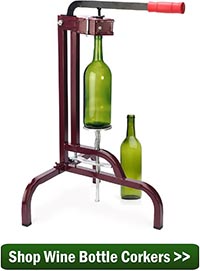 1. Are the mushroom cork or t-corks easy to install, or do you need special equipment. Do they seal as well as regular wine corks, (over time)?
1. Are the mushroom cork or t-corks easy to install, or do you need special equipment. Do they seal as well as regular wine corks, (over time)?
2. Wine bottles that have a screw top, can you reuse them with a wine cork?
Name: Tom H.
State: Davison, MI
—–
Hello Tom,
The T-corks (mushroom corks) are very easy to install. This is the biggest advantage to using them over traditional wine bottle corks. You do not need a wine bottle corker or any mechanism of any kind. You simply put T-corks in by hand. Every now and then you may get a stubborn one, but that can easy be remedied by tapping on it with a rubber mallet or similar.
The biggest disadvantage with T-corks is that they are not meant for long-term storage. Some wines made from fresh grapes or maybe elderberries may require several years of aging. These are not the corks to use for that situation. We recommend using T-corks for wines that you intend to drink within a one to two years.
 As to your second question about using wine bottle corks on a screw-cap wine bottle, the answer is “not advisable”. This is for two reasons. The first is that the size of the opening of the wine bottle is critical to the success of the wine bottle cork. The wine bottling opening needs to be 3/4″. This is not the case with most screw-cap wine bottles. They are all close, but usually off a bit.
As to your second question about using wine bottle corks on a screw-cap wine bottle, the answer is “not advisable”. This is for two reasons. The first is that the size of the opening of the wine bottle is critical to the success of the wine bottle cork. The wine bottling opening needs to be 3/4″. This is not the case with most screw-cap wine bottles. They are all close, but usually off a bit.
The second reason, and the one that is most important, is the shape of some screw-cap wine bottles are not correct to accept a wine bottle cork. The opening of the wine bottle needs to be a straight barrel. With some screw-cap wine bottles the barrel is not straight. The shoulder of the wine bottle rises too high to accommodate a straight barrel opening that a wine bottle cork needs, so what you end up with is a slightly-flared barrel opening.
Without this straight-barrel opening two things can happen:
- The
 cork does not seal tightly enough along the whole length of its side. As the barrel opening flares out, the resistance against the side of the cork becomes less and less.
cork does not seal tightly enough along the whole length of its side. As the barrel opening flares out, the resistance against the side of the cork becomes less and less.
- Because of this flaring and uneven resistance, it can actually entice the wine cork stopper to pull down into the bottle. I’ve seen this happen more than once. Think of squeezing a marble between your fingers. If you don’t squeeze it evenly or to one side, it pops out. This is the same effect that can happen when corking a screw-cap bottle that has a flared barrel.
Thanks for the great questions, Tom.
Happy Winemaking,
Ed Kraus
—–
Ed Kraus is a 3rd generation home brewer/winemaker and has been an owner of E. C. Kraus since 1999. He has been helping individuals make better wine and beer for over 25 years.

We have been making wine for several years now. We make it from kits as well as juice, concentrates and fresh fruit. We have always used the screw on bottles and tops. We now would like to switch over to corks. Is there anyway to make this transition cheaper by still being able to utilize any of our old bottles???
Linda, you can try using corks in the bottles you have, but you have to be aware of the warnings expressed in the above blog post. There are no products or "secrets" I know of that will resolve those potential issues.
I PREFER the screw-top bottles. Using tight fitting corks (#9) plus the screw top makes a seal with no chance of leaking or blowing out.
I’ve been banging my head trying to decide whether to us corks in my twist top bottles or just the twist cap. I will be using tight fitting #9 corks “plus” the screw cap; simple and effective. I will be using a manual type corker that compresses then inserts the cork; this way much less chance to break the bottle neck,
Re. your comment to Tom H. about reused screw cap wine bottles. I agree that screw caps plus corks isn’t a great idea. However, I reuse sterilized caps and bottles and I then make a positive air seal by dipping the first inch or so of the filled and capped bottle in hot sealing wax. Looks good too!
I started using the plastic t-top stoppers over 10 years ago and have never had a failure. I have opened wine that was 10+ years old and it still tastes great. I won’t re-use the tin screw on caps because I never felt good about trying to sterilize them, but the hard black plastic caps with the clear plastic insert can be used many times over. Many people bring me used bottles and I take the tin screw cap bottles to recycling. The plastic t-tops are just too good and too easy.
Do you use T-corks on Screw cap bottles
what are t-tops
Millie, T-Top is just another name for Mushroom corks. They are also sometimes referred to as bar tops.
I had a problem with space to fill at the top of the carboy and did not want to add any more wine so I shopped around and finally found some marbles which I sterilized and used to fill the space. Maybe this will help somebody else.
Any reason the mushroom caps can’t be reused?
Kristen, unfortunately the mushroom corks are not reusable.
I’ve been making wine since 2010. for regular corks after bottling, I leave the bottles upright for 3 or so days. I then store on their sides to keep the corks (wet). Never had a problem. some of this wine is 14months old.
I bottle most wine in recycled 4liter wine bottles w/same screw cap. After bottling i store lying down and check for leaks. These I re-tighten. Once there are no more leaks I stand upright and store in my 64 degree basement room. I do the same with recycled screw caps and same bottle.
I never had a problem in 7 yeas.
The question mentioned “mushroom corks” and “t-corks.” The question answered t-corks. However, to me the two are very different. Mushroom corks are what you take out of a Champagne (sparkling wine) bottle. Unfortunately, to put these corks into sparkling wine bottles it takes a rather expensive tool. These corks come as a straight cylinder of cork and the machine that puts it in the bottle forms the mushroom cap under great pressure. I’ve used t-corks for still wine. They are really handy for bottling up a wine for a party when you know the cork will come back out in a few hours. If making sparkling wine you will likely need plastic sparkling stoppers.
The biggest problem I have found with screw cap wine bottles is that when I refill them with wine and replace the original cap, it often leaks. Even when they are hand tightened as much as possible.
To fix this, I bought some good quality replacement caps on this site. However, many of the bottles have a small shoulder just below the threads, which prevents them from tightening down fully. Then they also leak. So I’m now recycling all my used screw cap bottles, as they become empty, and replacing them with corked bottles.
Unfortunately, more and more wineries are switching to screw caps, as cork prices rise, so it gets harder to find good reusable cork type bottles.
Hi there – I have re-used bottles that were originally “screw-topped” and never have had a problem with them leaking if proper care was taken in inserting a cork. The only problem that I seem to have noticed are the bottles themselves seem to be more thin-walled than a wine bottle requiring a cork. Thus, there is nor of a chance of breakage when either inserting or removing the cork.
What about the T-Cork bottles that have ridges in neck near the top to help facilitate the unscrewing…? Can those bottles “take” a normal cork? I’ve been recycling them thinking I can’t use them but most of the cork stopping power is at the bottom of the neck so I’m thinking they may actually be fine. I’m thinking the biggest concern is that they might tear at the cork during removal when you’re ready to open a bottle.
Yes, those should take a regular size 9 wine cork. You are looking for an opening that is 3/4″.